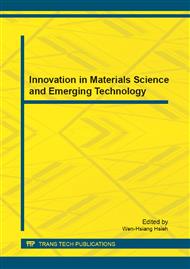p.415
p.420
p.425
p.430
p.436
p.441
p.446
p.451
p.455
Construct Concept Structure for Fundamental Mathematics
Abstract:
Currently, cognitive psychologists and mathematics educators are looking again at conceptual and procedural knowledge in mathematics learning. Building relationship between conceptual knowledge and the procedures of mathematics contributes to long-term memory of procedures and to their effective use. So we know that symbols could enhance concept and procedures apply concepts to solve problem efficiently. Sketch the graph of exponential function and logarithmic function. Find the inverse exponential function, logarithmic function and so on. The lack of other concrete example in general exponential and logarithmic function prevented the development of application about general exponential and logarithm. Numerical fundamental mathematic problems are provided with complicated number frequently. The lack of other concrete example in general exponential and logarithmic function prevented the development of application about general exponential and logarithm. Numerical fundamental mathematic problems are provided with complicated number frequently The conceptual knowledge, not mechanical algorithms, need more study and thought to identify. But there is a limitation for students use some materials to clarify complicated mathematic concepts perfectly. In order to insight the misconception of learning fundamental mathematics and progress teaching. The purpose of this study is to provide an integrated method of fuzzy theory basis for individualized concept structure analysis. This method integrates Fuzzy Logic Model of Perception (FLMP) and Interpretive Structural Modeling (ISM). The combined algorithm could analyze individualized concepts structure based on the comparisons with concept structure of expert. Applying the method of the cluster of fuzzy c-mean, we could distinguish characteristics of six groups. We analysis the whole data and discuss the relationship between knowledge structures of the sample. The result and discoveries from the research can offer pupils' misconception of learning fundamental mathematics with reference of diagnosis.
Info:
Periodical:
Pages:
436-440
Citation:
Online since:
December 2011
Authors:
Price:
Сopyright:
© 2012 Trans Tech Publications Ltd. All Rights Reserved
Share:
Citation:


